As the weeks go by and the days start to stretch, horse owners start to think about getting horses out of stables more and into the fields.
Arguably the best way to preserve grazing is to rest it over the winter months to prevent damage, but this is not always possible. Reducing the stocking density, only using well drained fields and keeping machinery off the land during wet periods can all help to reduce winter damage.
Winter grazed paddocks will need some rest and rejuvenation to get them back into good condition. However even those paddocks that have not been used will need help to be productive and supply good grazing over the season.
Grass Growth.
In the perfect world grass would grow at a consistent steady rate all year round and our horses would have an optimal supply with no excess or shortage. However, in reality this is far from true.
Grass growth is dependent on the weather, as it gets warmer in spring the grass begins to grow as it gets colder in the autumn the grass slows down its growth. Added to this we see a change in the nutritional value that can cause metabolic issues such as laminitis, growth issues and obesity.
As a general rule growth starts around mid March and reaches its peak in May then declines during June, July and August with a flush at the end of September beginning of October. This is something that we cannot control and in some years a cold April can delay the growing season and a mild Indian summer can extend it. As can be seen on the graph below even a dry summer has an effect.
Horses are known to be very selective in their grazing habits if not managed carefully paddocks soon become “horse sick” with areas of roughs and lawns. The less palatable grasses are left to seed in rough patches where the horses also dung & urinate. Tall growing weeds colonise these areas and continuous grazing with horses leads to severe deterioration in the quality of the grassland.
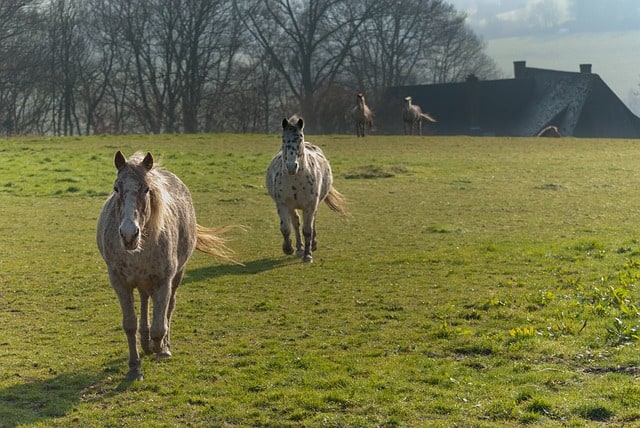
Where paddocks are overgrazed, the lawns become depleted in plant nutrients, the more productive grasses are suppressed and weed grasses and broad leaved weeds become established, over grazing and poaching in winter has the same effect. Soil tends to become acidic in its nature and the more organic content the more acidic it becomes.
The PH of Soil and Why it is Important.
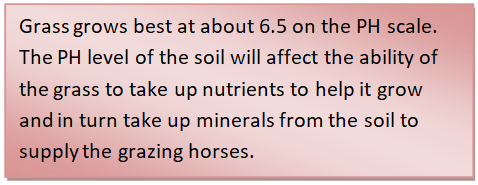
Grass needs to take up nutrients from the soil to be able to grow. PH measures the alkalinity or acidity of the soil with 7 being neutral and any lower value acidic any higher value being alkaline. Grass grows best at about 6.5 on the PH scale. The PH level of the soil will affect the ability of the grass to take up nutrients to help it grow and in turn take up minerals from the soil to supply the grazing horses.

It is always a good idea to have a soil test done to determine this and also to assess any mineral deficiencies. This can be done over the winter and depending on soil type only needs to be done every 3 to 5 years.
If the soil is too acidic lime can be applied at any time of the year but stock must be removed until it is washed into the soil. This is often a good pick me up as it will allow grass to access nutrients otherwise locked up and gives the grass a boost. I personally like to lime in the autumn when paddocks are being shut off for winter.
It is also important to try to send grassland into the winter with as little growth as is practical. This prevents frost damage to the sward and dieback of vegetation. This dead vegetation can smother the underlying grass plants and any dead material adds to the organic content and lowers the PH. If practical, grazing with sheep is an ideal way to clean up paddocks.
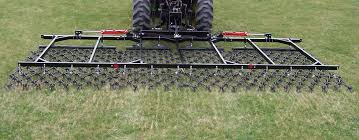
Begin with a Good Harrow!
In the spring once conditions allow for machinery to access, the first task is to harrow. Work cannot begin until the land is dry enough to take machinery.
Harrowing removes dead and matted grass that is clogging up the base of the plants, this dead material prevents air and light from reaching the roots and the soil.
Poorly aerated soil will not encourage grass growth. It also aids the levelling of poached or cut up areas and breaks up clods of earth. Grass grows by a method known as tillering, the use of the harrow encourages this, giving rise to more shoots, a thicker mat of grass and a more productive pasture.
Next Step – Rolling The Paddocks.
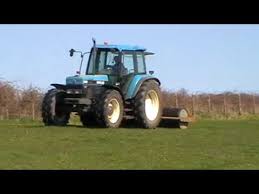
Once harrowed then the next task is to roll the field. This again encourages more shoots to be produced and firms the roots into the soil. A firm soil will warm up quicker and hold warmth to encourage growth. Rolling also helps to level areas that have been poached and to push stones down into the soil. It is a personal choice as to whether rolling is carried out before or after adding fertilizer.
If it is carried out after it can help to incorporate granulated fertilizer into the soil. Most contain a mixture of Nitrogen, Phosphorous and potassium. Fertilizer should be applied according to the results of the soil test and stock should be kept off until the fertilizer has washed into the soil.
Fertilizing the Paddocks.
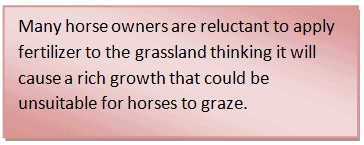
Many horse owners are reluctant to apply fertilizer to the grassland thinking it will cause a rich growth that could be unsuitable for horses to graze. In reality it is essential to replace the nutrients lost from the soil to maintain a suitable growth of the correct grasses for the horses. Obviously laminitic animals need close monitoring, but poor soil nutrients encourage weeds and discourage grasses.
Moderate applications of Nitrogen are necessary to improve grassland production and maintain fertility so that the more palatable and productive species of grass can survive.
Heavy applications of nitrogen produce very lush grass, which can cause diet related disorders. However nitrogen is leached out of the soil in wet conditions over winter and unless replaced by fertilizing, it can only be replenished by nitrogen fixing bacteria later in the growing season. These bacteria tend to be in the roots of clover and as clover is generally best kept to a minimum in a seed mix for horses the amount would have little value in replacing lost nitrogen.
Soils continuously grazed with horses are more likely to be deficient in phosphorous an essential element for grass growth, so should also be replenished. Potassium results are likely to be very variable even within small areas however cutting for hay or silage reduces the potassium in the soil.
Topping Grassland.
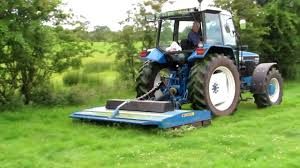
As already mentioned horses are selective grazers. They prefer to graze grass that is about 4 to 6 inches in height, before it has become stalky or gone to seed. This grass is nutritious and palatable. It also suits how their dentition has evolved to bite off and to chew the grass.
It may seem a waste, but topping excess grass will keep the grass at the optimum grazing height and encourage better growth and a thicker sward that will give cushioning and prevent poaching. If there is a lot of topped material then it is a good idea to collect it up so it will not smother the grass underneath. Remember Stock should be removed before topping and not returned to the pasture until it is safe to do so.
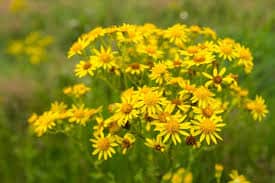
Always check before topping for the presence of ragwort as this is more palatable when dead and is poisonous! Make sure it is pulled up by the roots and disposed of carefully.
Dealing With Weeds.
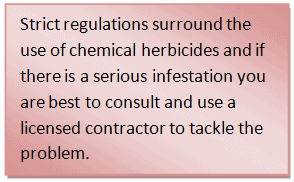
Dealing with weeds is always an issue, 1 year of seeds and 7 years of weeds. Strict regulations surround the use of chemical herbicides and if there is a serious infestation you are best to consult and use a licensed contractor to tackle the problem.
Remember weeds take up sprays best when actively growing so spraying a couple of weeks after applying fertilizer is most effective. Stock should be removed from grazing for the recommended period after application depending on the herbicide used.
Strimming and pulling will tackle weeds in small areas. The correct application of fertilizer while avoiding getting dung patches will also help to control weeds.
In small paddocks dung can be collected to help prevent areas becoming sour and under grazed. It will also help to reduce worm burden on the pasture. However, in large areas this may not be possible. Harrowing on a hot day will help to spread the droppings and kill off the parasite eggs and lave.
As grass growth slows down in June and July it is always an option to apply a light dressing of fertilizer to encourage the growth and give a more consistent growth pattern. It is also possible to in sow some mid season grasses that will grow during this period of the year. Different grasses grow at different times of the year and by incorporating early, mid and late season grasses it can extend your grazing season.
Grass remains the most natural and cheapest feed for horses, managed correctly grazing provides numerous benefits for our horses. It is time consuming and often expensive but when you consider the investment in the land and the stock then spending time and money on maintaining your grazing is well justified.
This Article was written by Jessica Soley BHSI and was originally published in Irish Sport Horse Magazine March 2019. Jessica Soley BHSI is a Level 5 Performance Coach and Senior Assessor for The British Horse Society. Having Competed and Run her own Competition Yard she is now an Equine Tutor for the QQI Equine Courses at level 5 & 6 , run by KWETB in Kildare.
